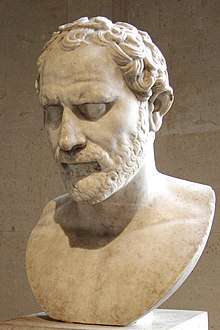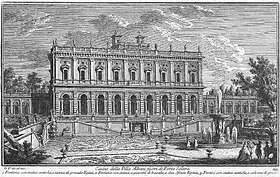Alessandro Albani
Alessandro Albani (15 October 1692 – 11 December 1779) should be best remembered as a leading collector of antiquities, dealer and art patron in Rome. He supported the art historian, Johann Joachim Winckelmann and commissioned paintings from Anton Raphael Mengs. As a cardinal (from 1721) he furthered the interests of the governments of Austria, Savoy and Britain against those of France and Spain; he was a noted jurist and papal administrator in his earlier career.
.jpg)
Biography
Alessandro Albani was born in Italy on 15 October 1692 in Urbino, then part of the Papal States. He was the son of Orazio Albani. His education at La Sapienza University in Rome was towards a degree in jurisprudence. Early in life he also studied for a military career. He was made an honorary member of the military brotherhood of justice of the Knights of St. John, Rome, on 26 August 1701, at the age of nine, and a colonel of a regiment of dragoons in the pontifical troops, in 1707. Alessandro Albani descended from the Albani family (branch of Urbino), which originated from into the Albani (family) that had established itself there from northern Albania in the 15th century.[1] Alessandro's father, Orazio, was the brother of Pope Clement XI Albani, who convinced Alessandro to set aside his budding military career, for which the weakness of his eyesight, that led to blindness in his advanced age, did not recommend him, and become a clergyman. After Pope Clement XI's death in March 1721, Pope Innocent XIII appointed Alessandro as a cardinal, on 16 July 1721 as Cardinal-Deacon of Sant’Adriano al Foro - for which Alessandro required numerous special dispensations, not least because his brother, Annibale Albani, had been made a cardinal in 1711 and still sat in the Sacred College[2]

Albani developed into one of the most astute antiquarians of his day, an arbiter of taste in the appreciation of Roman sculpture, and "a powerful and enterprising collector of Roman antiquities and patron of the arts... He used both ancient and modern art as a form of cultural capital," Seymour Howard observed,[3] "giving away acquisitions as favours and selling them for perpetually needed funds or when they lost efficacy for him." His first apprenticeship in this area was served under the papal antiquary and curator Marcantonio Sabatini.[4]
He was the formal protector of Rome's artists as patron of the Accademia di San Luca and was a powerful advocate for his favourites. Among the works of modern artists that passed through his hands was the album of drawings by Carlo Maratti that was sold in 1763 to George III and is conserved in the Royal Collection.[5]
His worldly manner and his sympathy with the Hanoverian party in Britain[6]- (Clement kept the Stuart pretender as his perennial guest in Rome) was exemplified by his friendship with Baron Philipp von Stosch, who shared many of Alessandro Albani's interests, and his correspondence with Sir Horace Mann, the British envoy at Florence,[7] who caused Clement many occasions of concern. Named papal envoy, with his brother Cardinal Carlo, to Bologna to welcome King Frederick IV of Denmark, he was sent in 1720 to Vienna in an attempt to retain Papal territorial rights in the duchy of Parma and Piacenza, recently awarded to Charles de Bourbon, and to conclude the negotiations for the restitution of Comacchio, in the possession of Habsburg troops since 1707. Sir Horace Mann, at the request of the Cardinal, arranged for John Chute of 'The Vyne' in Hampshire, who was enjoying the Grand Tour, to spy on the Jacobites, who were in Rome making their plans for an invasion of England from Scotland. Information he collected was passed to Albani and then sent to England. Chute was a member of the Gay group known as the 'Finger Twirlers'. They included Horace Walpole and Thomas Gray the poet. Eventually, Chute was forced to flee, having been twigged.

His accommodating manner suited him for diplomatic tasks, such as the successful negotiations with Vittorio Amedeo II over conflicting rights of nomination and investiture, aggravated by the acquisition by the House of Savoy of Sardinia, over which the papacy had long-standing feudal pretensions. Accords were finalised in 1727 during the papacy of Pope Benedict XIII, for which Vittorio Amedeo thanked Cardinal Alessandro with a rich abbacy and the title of "Protector of the Kingdom". Within the Papal Curia, however, the party of the zelanti considered the accords too generous in their terms. Tensions increased with the pontificate of Clement XII, unsympathetic to Savoia. When a new concordat was arrived at in 1741, Alessandro Albani signed on the part of Savoia.
As a cardinal he participated in the conclaves of 1724, 1730, 1740, 1758, 1769, and 1774-1775. He announced the elections of Pope Clement XIII (1758), Pope Clement XIV (1769) and Pope Pius VI (1775). His consistent stand against French interests brought him closer to those of the Habsburgs; Cardinal Albani represented Habsburg Austria at the Holy See, from 1756 until his death. He was appointed Librarian of the Holy Roman Church on 12 August 1761.
From the time of the papacy of Pope Clement XIV he realigned himself with the zelanti against the interference of Roman Catholic monarchs in the diplomacy that surrounded the eventual expulsion and Suppression of the Jesuits from most Catholic Christian countries.
He died on 11 December 1779. He was buried in the Observant Franciscan Church of San Pietro in Urbino, Marche, Italy.
Villa Albani
Alessandro commissioned in 1745 the construction of the prominent Villa Albani in Rome. Building began in 1751 according to Giuseppe Vasi and celebrated as complete in 1763,[8] to house his evolving, constantly replaced and renewed collections of antiquities and ancient Roman sculpture, which soon filled the casino that faced the Villa down a series of formal parterres. Albani's lifelong friend Carlo Marchionni was the architect in charge, at the Villa and perhaps also for the two temples in the park, an Ionic temple of Diana and a sham ruin. The Albani antiquities were catalogued by the Cardinal's secretary, the first professional art historian, Johann Joachim Winckelmann, who was supported by Albani from the time when the Seven Years' War stranded him in Rome without his pension, and whose own connoisseurship was sharpened by the connection.[9]
After the Napoleonic upheavals the Albani heirs sold the villa to the Chigi, who were themselves related to the Albani and by this time had added the Albani name to their own. The Chigi eventually sold it to the Torlonia, the Roman bankers, to whom the villa still belongs. Cardinal Albani's coins and medals went to the Vatican Library, over which he had presided from 1761. The sarcophagi, columns and sculptures have been dispersed, but the famous bas-relief of Antinous remains in the villa.
Cardinal Alessandro Albani had another villa and park at Porto d'Anzio, that was finished in February 1732,[10] but was habitable for a few weeks only in spring because of malaria. Perhaps the villa and a casina in the park were by Marchionni.[11] Excavations in the park brought to light many ancient Roman sculptures.[12]
Further reading
- Debenedetti, ed., Alessandro Albani, patrono delle arti ... = Studi sul Settecento Romano; 9 (1993)
See also
- Albani (disambiguation)
| Records | ||
|---|---|---|
| Preceded by Carlo Alberto Guidoboni Cavalchini |
Oldest living Member of the Sacred College 7 March 1774 - 11 December 1779 |
Succeeded by Ludovico Calini |
Notes
- Herbermann, Charles George; Knights of Columbus; Catholic Truth Committee (1913). The Catholic Encyclopedia. The New York Public Library: Robert Appleton Company. p. 255. Retrieved 12 May 2010.
illyricum sacrum albanian.
- Other cardinals of the Albani family include Gian Girolamo (1570), Gian Francesco (1747), and Giuseppe (1801) (Catholic Encyclopedia).
- Seymour Howard, 'Some Eighteenth-Century 'Restored' Boxers', in Journal of the Warburg and Courtauld Institutes; 56 (1993, pp. 238-255) p. 238f.
- Howard 1993:239.
- John Fleming, "Cardinal Albani's drawings at Windsor — their purchase by James Adam for George III", The Connoisseur 142 (1958:164-69; A. Blunt and Cook's catalogue.
- were notorious and Albani was the representative of Maria Theresa in Rome. As Austria's ally, Britain, had no official representation, Albani performed necessary duties
- The Albani-Mann correspondence forms a large part of the documentation of Lesley Lewis, Connoisseurs and Secret Agents in Eighteenth-Century Rome, 1961.
- A brief bibliography of Albani and Villa Albani is given in Howard 1993:239 note 2.
- "Winckelmann, like other eighteenth-century 'Arcadians' before him, served as Albani's ally or minion, not as his director," Howard observes (Howard 1993:239.).
- According to the inscription on a drawing of the villa's ground-plan in the possession of Anthony Blunt, noted in The Burlington Magazine 111 No. 792 (March 1969:164f).
- The casina illustrated in J. Gaus, Carlo Marchionni. Ein Beitrag zur römischen Architektur des Settecento, fig. 47.
- Roberto Piperno, "Rome art lover"
External links
- Cardinals of the Holy Roman Church: Alessandro Albani
- Casino of the Villa Albani
- Cardinal Albani and the Villa Albani, Anzio
- Dizionario Biografico degli Italiani, 1, pp. 595-598: Albani, Alessandro